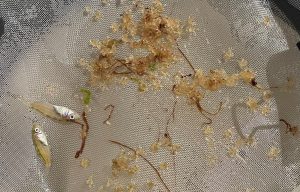Workshop examines how to use eDNA-based method to monitor OA’s biological effects

A group of 15 scientific experts has developed a coordinated West Coast plan for using environmental DNA (eDNA) to track the effects of ocean acidification (OA) on vulnerable shell-forming organisms – an approach that has the potential to generate different types of insights than manually inspecting for signs of shell dissolution under a microscope.
During a two-day workshop held in mid-March and hosted by SCCWRP, experts on eDNA and West Coast OA monitoring agreed that analyzing the DNA from pteropods, crab larvae and other tiny shell-forming organisms could serve as a valuable line of evidence for tracking OA’s ecological effects along the West Coast; these organisms are having a tougher time building and maintaining their shells as a result of OA.
Workshop participants also developed a framework for how to standardize an eDNA-based monitoring method for the West Coast. Standardization will pave the way for researchers to stitch together eDNA data sets to paint a West Coast-wide picture of how OA’s ecological effects are unfolding.
eDNA-based monitoring uses the DNA shed by organisms into their environment to identify the levels and types of organisms that were present – an alternative to traditional manual identification of organisms by trained taxonomists. eDNA-based monitoring is being piloted across multiple types of aquatic environments nationwide.
Researchers envision eDNA-based OA monitoring serving as a cost-effective, insightful complement to an OA shell dissolution method that’s already been standardized for use by programs including the Southern California Bight Regional Monitoring Program.
The shell dissolution method focuses on assessing shell-forming organisms under a scanning electron microscope to visually quantify the degree of shell damage caused by OA. SCCWRP helped standardize this method for pteropods four years ago in partnership with multiple West Coast OA monitoring programs.
By contrast, eDNA-based OA monitoring counts the number of organisms in a water sample – known as abundance – to estimate the degree to which OA has affected organisms at the site.
Workshop participants agreed that neither monitoring method is perfect on its own, but that the two methods have the potential to be particularly insightful if used together.
For example, the eDNA method, which looks for the presence or absence of organisms, is not designed to definitively link the absence of a shell-forming organism to the corrosive effects of OA – whereas the shell dissolution method can make this linkage.
Meanwhile, the shell dissolution method is limited to tracking only species for which manual shell dissolution analyses have already been standardized – whereas the eDNA method, once standardized, will be able to track a wide range of species simultaneously.
eDNA-based analyses also are a faster, cheaper method than manually examining shells under a microscope.
Workshop participants agreed that researchers should focus on adapting a technology known as quantitative polymerase chain reaction (qPCR) to analyze eDNA samples.
OA is a global phenomenon in which seawater chemistry is moving to a more acidic state and becoming less habitable for a range of organisms. West Coast ocean managers have prioritized tracking when, where and how these changes are playing out; ocean circulation patterns make the West Coast uniquely vulnerable to OA.
Workshop participants agreed that while water eDNA sampling methods have already largely been harmonized across marine monitoring programs, researchers still have more work to do to standardize eDNA analysis methods. Specifically, researchers need to standardize interpretation of eDNA data, integrate existing data sets, and process existing eDNA sample archives. Coordination has been lacking among West Coast OA monitoring programs, which has resulted in fragmented eDNA data sets.
Workshop participants included multiple SCCWRP member agencies, including the California Ocean Protection Council, Orange County Sanitation District, and City of San Diego.
SCCWRP will summarize the workshop findings and recommended next steps in a technical report, expected to be published in mid-2025.
For more information, contact Dr. Susanna Theroux.
More news related to: Bioassessment, Climate Change, DNA Barcoding, Ocean Acidification and Hypoxia, Top News